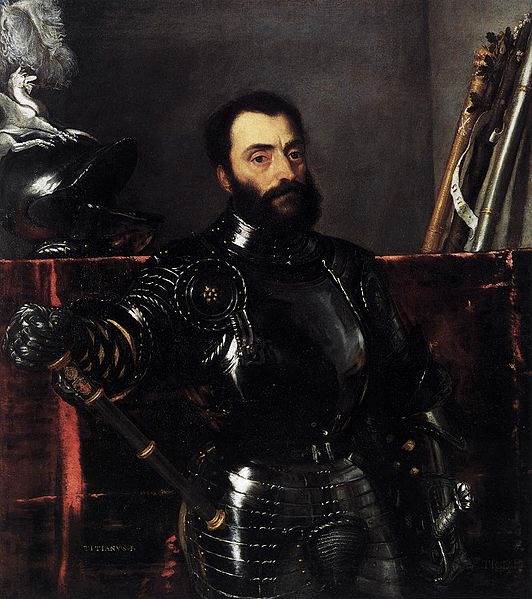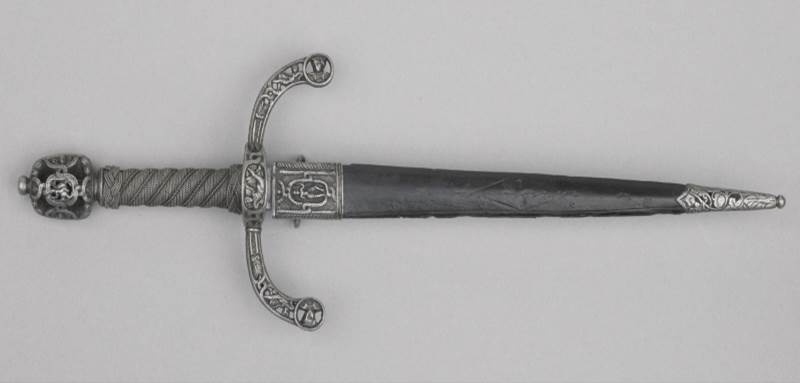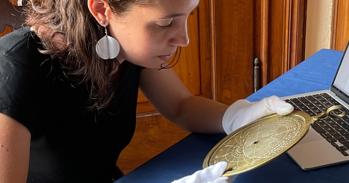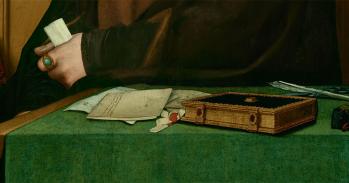
The trappings of violence were embedded into the culture of 16th century Europe. Victoria Bartels, a PhD candidate in the Faculty of History, has conducted research in a Florentine archive to show how, even at a time when the bearing of arms was prohibited, men negotiated ways to sport their daggers and swords in public.
The trappings of violence were embedded into the culture of 16th century Europe. Victoria Bartels, a PhD candidate in the Faculty of History, has conducted research in a Florentine archive to show how, even at a time when the bearing of arms was prohibited, men negotiated ways to sport their daggers and swords in public.
Violence, albeit in appropriate circumstances, appears to have been one method of demonstrating one’s masculinity. Yet to receive the benefits of this cultural capital, violent acts had to be performed publically under socially agreed terms, and especially in front of other men.
Victoria Bartels
Brawls tend to take a familiar pattern. Verbal insults are traded and physical violence erupts. Something like this happened in the graveyard of a church in Florence on 30 March 1561. It began when a man named Niccolo di Piero Parenti called another man, Piero di Domenico, un asino (an ass). Both men soon drew their swords. Two others joined the fray – and Piero was wounded (his big toe was badly cut) leaving him unable to walk properly.
A remarkably detailed report of this encounter between a pair of hot-headed Florentines appear in the annals of the Otto di Guardia e Balia, records kept by the magistrates responsible for overseeing criminal affairs and law enforcement in Tuscany under the Medici, the dynasty which ruled this domain for close to three centuries.
Few scholars have investigated the archives of the Otto di Guardia which represent a vast and under explored historical source. But in 2015 Victoria Bartels, a PhD candidate in the Faculty of History, spent two months studying these hand-written records. It was an undertaking that required not just a grasp of 16th century Italian but the determination to track down the meanings of dozens of obscure or archaic terms – from verbal jibes to items of armour. She was amused to discover that the insult poltrone translates as ‘armchair’ and means something akin to slob.
Bartels’ research into the usage of weaponry in Renaissance Florence forms one strand of a dissertation in which she will explore the relationship between men and armour (as well as martial fashion trends) in the 16th century. Her quest to understand more about the ways in which men used these items as masculine signifiers during this period takes her on a voyage into art, literature and archival documents that have survived more than 400 years of history.

Late Renaissance Italian culture was characterised by warfare. The so-called Italian Wars involved much of Europe and a preoccupation with armed struggle and violence was reflected in pastimes (such as jousting) and in male deportment and dress. Weapons (like those drawn in the graveyard in March 1561) were prohibited in 16th century Florence in order to maintain peace. But exceptions could be made and the contents of the Otto di Guardia archives suggest that many were.
As well as holding records of thousands of incidents of violence, the Otto archives also contain a huge collection of letters called suppliche (supplications) that petition the Duke for exonerations, sentence reductions, or the granting of certain privileges. Among these documents are numerous letters in which men wrote to ask the Otto for permission to wear or carry, in public, weapons that were banned.
Speaking today, at the 62nd Annual Meeting of the Renaissance Society of America in Boston, Bartels will show for the first time how these letters shine a light on the ways in which Renaissance men used weapons and armour in their daily lives to promote a masculine image – and how entrenched the notion of honour was in early modern society. The supplications are rich in information not only about what offensive and defensive arms men sought to wear but where in town they wished to go and how they wanted to be seen.
“The supplications are very specific in what they set out – and these details are what make them so valuable. In order to be given permission to bear arms a man had to specify with some precision what items he wanted to carry, when he wanted to be able to carry them, and why. The letters include a plea from a Portuguese priest who asks for permission to carry a dagger, and his man servant to carry a sword, for protection against a rowdy group of farmers and youths who are demanding his removal from a small parish church,” says Bartels.
“As a historian interested in the cultural history of arms and armour, it’s fascinating to hold in my hands letters that describe a whole range of situations and discuss both the usage and significance of these objects. The accounts written by notaries follow a template of sorts. However, each story is tailored to the individual behind the request. Although the level of detail varies, these documents provide historical information that we might not otherwise encounter. Every piece of material included, or withheld for that matter, assists us in our quest to understand period norms.”
Successful supplicants were awarded licenses by the Otto. Bartels’ research in the Archivio di Stato di Firenze led to the discovery of one such license – a copy of a document issued in March 1557. The license in question was granted to a painter called Maestro Giovanni Fiammingo Pittore. It gives his address and age (35 years) and describes his appearance (“black hair, black bushy beard, white in the face, medium stature”) and gives him permission to carry “an armed jacket, sword, and dagger”.

It is interesting that Maestro Giovanni was a painter and, as such, attuned to the powerful symbolism of arms and armour. The irony of portraying civilians equipped for combat was not lost on another artist. In 1584 Giovanni Paolo Lomazzo wrote that “merchants and bankers who have never seen a drawn sword and who should probably appear with quill pens behind their ears, their gowns about them and their day-books in front of them, have themselves painted in armour holding generals’ batons” (translation by Carolyn Springer).
Portraits and inventories reveal how a culture of warfare, tied up with notions of chivalry revived from earlier times, permeated deep into the male psyche and into male fashion – especially among the elite. An inventory of the guardaroba (wardrobe) of Lorenzo de’ Medici, as shown by Mario Scalini, itemised various pieces of armour including the de facto ruler of Florence’s leg armour that he wore around the city for decorative purposes.
Jousts, melees, and other tournament games were fabulous excuses for donning steel. The author Antonio Bendinelli recorded a tournament held in 1574 for Don Juan of Austria. Bartels says: “He discussed the appearance of each contestant over a span of 45 pages, commenting on the colour and material of their armour, clothing, and plumes. In contrast, he summed up the actual joust in just 20 lines, as historians Richard and Juliet Barker have pointed out.”
Looking manly, and impressing the opposite sex, meant adopting a martial style. The celebrated Florentine sculptor Benvenuto Cellini suggested that cavaliers wore mail armour to impress women and, in 1538, the artist himself is recorded as possessing an entire wardrobe of mail. However, being perceived as overly militaristic also had its drawbacks. In Baldassare Castiglione’s The Book of the Courtier (1528), a female character explains to a surly, overly militaristic man: "I should think that since you aren't at war at the moment and you are not engaged in fighting, it would be a good thing if you were to have yourself well greased and stowed away in a cupboard with all your fighting equipment, so that you avoid getting rustier than you are already."
For statesmen, the consequences of going without armour could be deadly. In 1476 a grim fate befell the Duke of Milan, Galeazzo Maria Sforza, who was assassinated in one of the city’s churches. “We know from a courtier’s account that the Duke had decided against wearing his corazina [upper body armour] the morning of his death because it made him look portly,” says Bartels. “His decision was a revealingly human, but fatal, trade-off between form and function. His desire to look slim and dashing in public may have cost him his life.”
16th-century notions of gender welded manhood and masculinity with arms and armour. In a letter written in 1572, Antonio Serguidi noted that Duke Cosimo I wept with pride when he saw his youngest son Giovanni kitted out in armour, and holding a pike and mace. The putting on of armour was a mark of adulthood – and, perhaps, was a rite of passage with no return. The showy masculinity of martial dress, however, trod a delicate line along a sliding scale – with restraint at one end and acts of violence at the other.
Citing the scholars Lyndal Roper and John Tosh, Bartels suggests that a man’s level of manliness was never fixed but existed in a state of flux. “Violence, albeit in appropriate circumstances, appears to have been one method of demonstrating one’s masculinity. Yet to receive the benefits of this cultural capital, violent acts had to be performed publically under socially agreed terms, and especially in front of other men,” she says.
“Arms and armour seem to have been visible manifestations of this concept. Even if men didn’t fight, the objects they carried made it look as though they would and likely influenced their comportment and behaviour. Today we see these items in static museum displays – but to those who saw them worn their potentially lethal function was never in doubt. However, these same objects simultaneously conjured up notions of civility and chivalry, making the symbolism of arms and armour somewhat contradictory, similar to the period’s understanding of masculinity itself.”
The gaining and defence of honour – whether for an individual, for family or for state – was the ultimate goal of the Renaissance man. The Otto di Guardia’s archives in Florence reveal that Niccolo, who engaged in a brawl with Piero almost exactly 455 years ago, was the only person to be charged with a crime. He was ordered to pay a fine for the insulting word he used and for the injury to his opponent’s foot. Though others joined the fracas, they were let off.
As Bartels explains: “Niccolo was convicted because he sullied the honour of Piero. As seen in other parts of Europe at this time, the authorities were sympathetic to fighters who were provoked by the spewing of verbal insults.”
Victoria Bartels will give her talk, ‘Men of Steel‘, today at the 62nd Annual Meeting of the Renaissance Society of America in Boston. She is contributing to a session called ‘Encountering the Renaissance, Honoring Gary Radke III: Regulating and Shaping Gender and Sexuality’.
Inset images: Titian, Portrait of Francesco Maria della Rovere, Duke of Urbino, 1536-38 (Galleria degli Uffizi, Florence); Parrying dagger with scabbard, Italy or Germany, ca. 1590 (Wallace Collection).

The text in this work is licensed under a Creative Commons Attribution 4.0 International License. For image use please see separate credits above.




